Story can happen anywhere. Scenes from my novels have unfolded in a busy Glasgow airport, in a poorly lit hotel room in Dallas, on a kitchen counter in Auckland, in the passenger seat of a car rolling through rural Ohio, on a coffee table in Johannesburg.
When deadlines loom, writers write, no matter where life finds us.
Still, my favorite place to work is at home in a single, purpose-built room above our garage. In this sacred space, I gather my research books around me, meet with my cast of characters, and follow them about, jotting down everything they say and do, until their tale is finally told.
Let me take you on a virtual tour of my writing study, while I share 10 Things Every Novelist Needs.
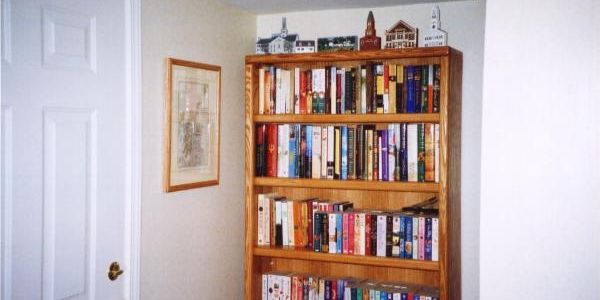
1. Every novelist needs a door. See that one on the left, with the lock? On the other side, a hand-made sign hangs from the knob, warning all comers, “Do Not Enter.” Even if you don’t have a whole room to yourself, even if all you have is one corner of a spare bedroom or the other end of your dining table, use a room a divider, hang a blanket, prop up a cardboard screen—something, anything that lets people know, “I love you, but please stay away just now. I’m writing.”
2. Every novelist needs inspiration. One foot inside the door and we’re greeted by shelves filled with historical novels from various time periods. When I get stuck, when I can’t seem to rub two words together to create a spark, I grab a novel by someone whose work I admire and read a page or two. Not so I can copy their style—heaven forbid!—but so I can recapture the natural rhythms of Story.
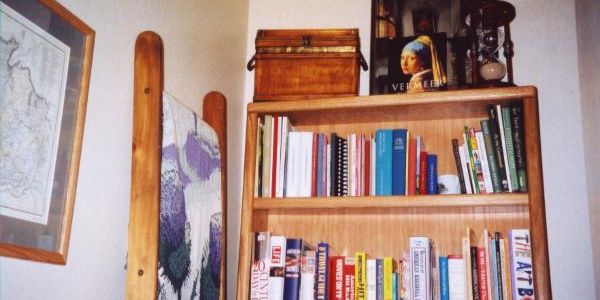
3. Every novelist needs resources at the ready. The Internet is invaluable, but you still need lots of reliable books at hand. We’ve taken just three steps up to a landing, where yet another bookshelf holds court. These were resources for my lighthearted contemporary novels. I wrote just two—Mixed Signals (1999) and Bookends (2000)—plus a novella, Fine Print, in a collection called Three Weddings and a Giggle (2001)—before turning to historical fiction for good, but even contemporary stories deserve our best research efforts.
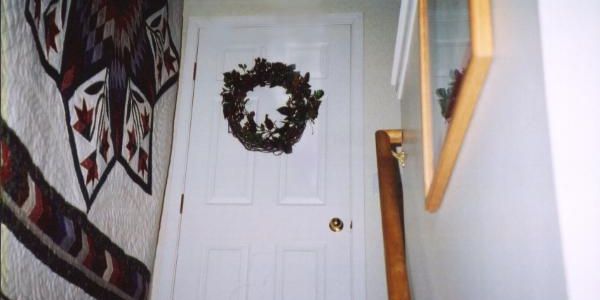
4. Every novelist needs a restroom. Go ahead and laugh, but you know it’s true. The necessary at the top of these steps started out as a closet. When I realized how much time it took to walk down the stairs, through the office, along the sidewalk, into the house…well, you get the idea. And invariably I’d find something to distract me while I was away from my desk. So, once finances allowed, we called a plumber. Now this very small room serves a very fine purpose: it keeps me in Story.
5. Every novelist needs a collection of books about writing. As you can see, even my wee necessary offers plenty of reading material. This is where I keep all my books about the writing process itself. Anne Lamott’s Bird by Bird, Donald Maass’s Writing the Breakout Novel, William Zinsser’s On Writing Well, Browne and King’s Self-Editing for Fiction Writers, John Gardner’s The Art of Fiction, Christopher Vogler’s The Writer’s Journey, James Scott Bell’s Plot and Structure, and two dozen more favorites.
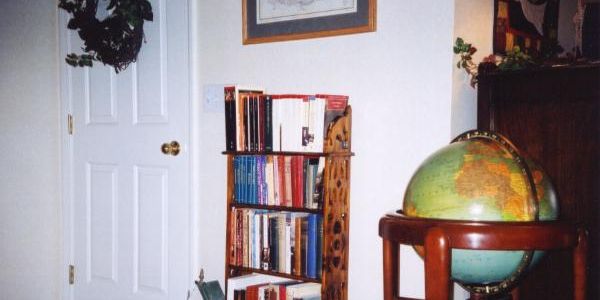
6. Every novelist needs to read the classics. At the top of the steps sits a bookshelf full of British fiction classics: Austen to Barrie to Buchan to Hardy to MacDonald to Scott to Stephenson. When I’m writing a novel set in a particular time period, I’m also reading a novel actually written during that time period. So, Samuel Richardson’s Clarissa, published in 1747, was on my night stand while I was writing Here Burns My Candle, set in 1745-46.
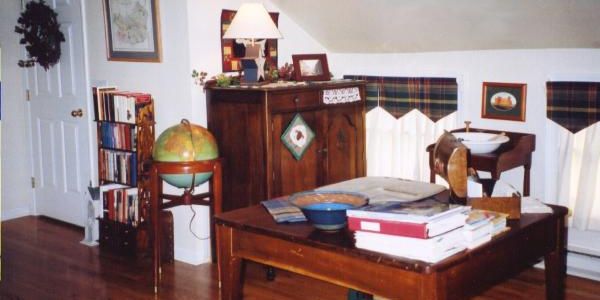
7. Every novelist needs a globe. Maps are marvelous too. Anything to give us a sense of place, wherever our novels might be set. This is a wider view of my study, showing the table of resources behind my desk, my old lighted globe, and a 19th-century washstand I picked up for a song.
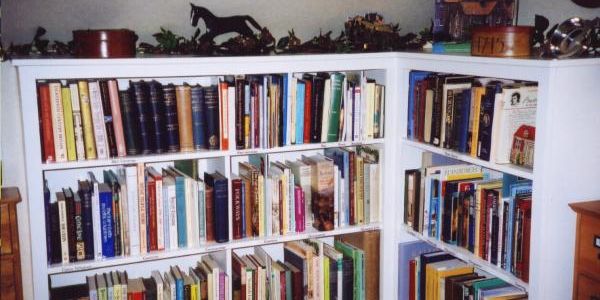
8. Every novelist needs an obsession. Mine is, obviously, Scotland. To the left of my writing desk begins my Scottish collection of books—Architecture to Art to Birds to Costume to Covenanters to Customs to Domestic Life to Edinburgh to Festivals to Folklore to Food to Galloway.
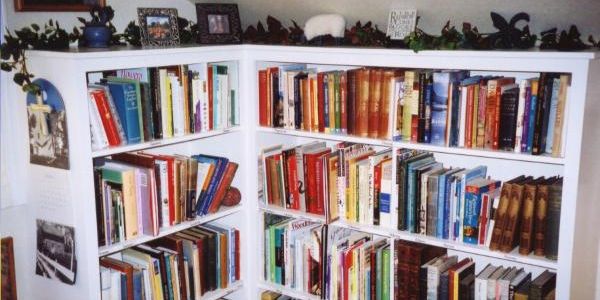
To the right of my desk, more shelves containing the rest of my Scottish collection—Gardens to Highlands to History to Jacobites to Letters to Money to Poetry to Religion to Ships to Tartans to Travelers to Writers. These are, to be honest, older photos from tidier days. Stacks upon stacks of new additions are waiting to be shelved. When we build more shelves. If we build more shelves.
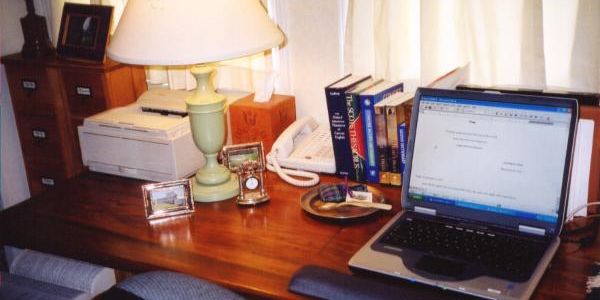
9. Every novelist needs physical objects that capture the time and place of his or her Story. This side of my desk includes a pewter plate, a horn spoon, and a tartan sachet filled with Scottish lavender. It’s easily a dozen years old, yet still as fragrant as the day I bought it on the Isle of Mull, and the best way to quickly dispatch a headache.
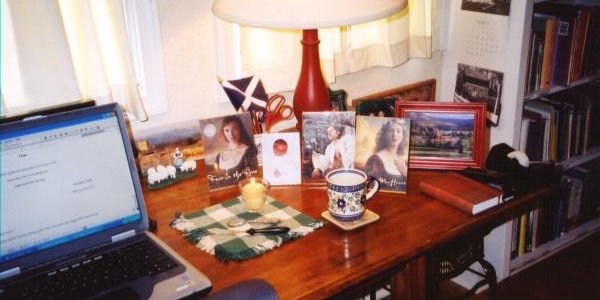
Here are more tactile memories of Scotland: a fragrant candle, a teacup, a flock of sheep, an antique paper knife, a Victorian magnifying glass, and a wee blue-and-white Saltire flag.
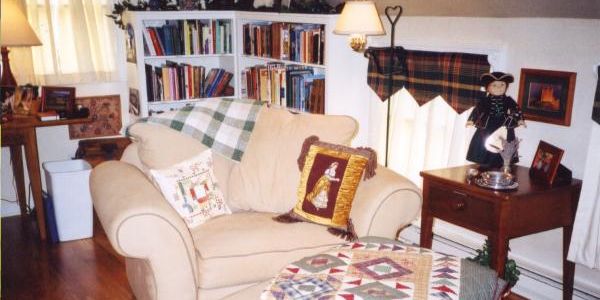
10. Every novelist needs a place to take a nap. This is where I curl up to read and mark manuscript pages after I finish a chapter. If I fall asleep reading my own book, that’s a definite sign it needs more editing. The needlepoint pillow of “Rose” from Fair Is the Rose was a Mother’s Day gift. And, for all fans of American Girl dolls, that is indeed Felicity on the side table.
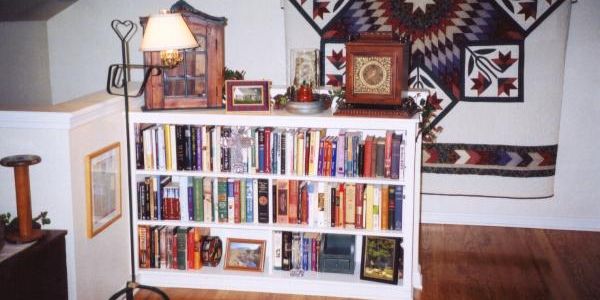
There you have it: a virtual tour of my writing study, along with a few thoughts to consider for your own writing nest.
If you have questions about writing fiction or about my Scottish novels, kindly Leave a Reply.
It’s an honor to count you among my readers. Haste ye back!

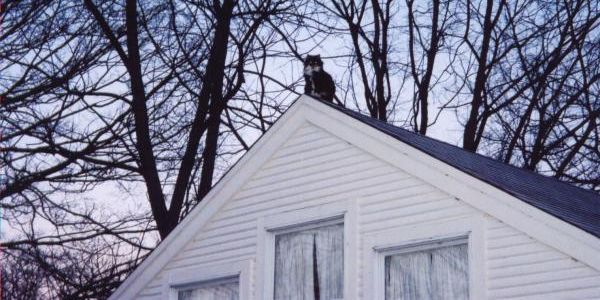
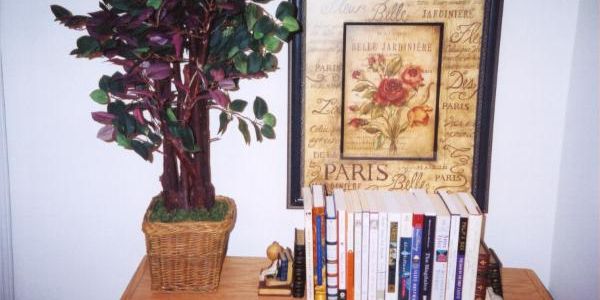
 Subscribe to the blog via RSS
Subscribe to the blog via RSS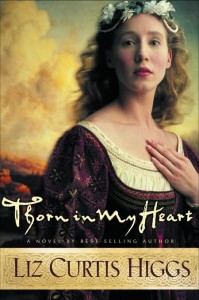
Lizzie, thank you for taking us on this tour of your writing space. “A wee little spot!” Cried by a tiny Scottish lass, named Fiona, whose parents were members of Hamilton Baptist Church at that time led by Pastor Alistair Begg, who had early in the day had us “play sword drills” in Church! The colors of the sanctuary were light turquoise and pink and white, vibrant cheerful colors. Fiona had tried to use the bottom of the tea cart for her stuffed donkey, a gift from a recent vacation trip to Spain, and implored her slightly embarrassed parents, Frederick & Elizabeth, to just let her have the wee little spot! It was one of many delightful memories of our trip to Bonny Scotland, 1981! Fiona, Lorna & Hazel were the daughters names. one weekend, a long time ago yet that event is crystallized in our mind like yesterday!
I love Felicity & AG, MY GRANDDAUGHTERS & I have a bit of a collection! Thank you for giving us permission to have a few momentos, treasures, beloved books, photos. Wow, you have created such new classics…I thought I was the only one whose books out measure our cases!
Love, Marte
Lovely to hear from you, Marte, Such fond memories, aye? I’ve heard Alistair Begg speak (marvelous!) and can picture that cheerful sanctuary. Thanks for sharing!
Thank you so much for your thoughtful insight and sharing so much of yourself with us. I just love the way your mind works, Liz.
Thank you dear friend for letting us into your creative world !!
So glad you paid me a visit, Joy!
Not a novelist – but loved the virtual tour of your writing studio, & your comments. I can visualize you sitting there working & would love to be a “fly on the wall” so I could view your writing genius at work – for real! Thanks for the entertaining & informative tour, but most of all – the wonderful books you write there!
It’s my joy to let readers take a peek inside my study! And thanks for the kind words about my novels, Bonnie.
Well, You Asked If We Had A Question: How do you begin? Research? Then, plot and finally write?
My hubby and I had to move about quite frequently when first married, because of his work (radio), and we often tell each other, we could write a book! (at least a pamphlet…)
Loved loved loved your tour. Very inspirational, because if you could see my book shelves…must tidy them this Spring!
Thank you for *all* the beautiful photos, your stories and your Bible studies.
Yes, research first, then plot, then more research, then more plotting, then writing, then more research, then in the end, throwing the plot out and letting the characters tell their story! Press on with that “pamphlet,” CarolAnne!
you nailed it…the process of writing a book. Thanks!
Thank you for the lovely trip to your sanctuary! I was surprised that you write on a small laptop rather than a regular PC. Is that so you can take it along? Love your quilts and little bits of Scotland, and was that a wee picture of a grandchild? Liz, I did not receive a yearly newsletter or any bookmarks or any other goodies.. Did those go out? My alter ego is Rebecca Mick Frith and I’ve been a fan for several years. I’ll bid you welcome to OK a bit early and wish you well. I don’t attend big events any more because of poor hearing, but I wake every morn to Rise and Shine with you. I’ve been thru the book more than once, but I still love starting my day with your words of encouragement.
You are so right: I used to write on a laptop, as shown here, to make it easy to grab and go. Since then, I’ve switched to a full desktop PC in my writing study. Still have a laptop for the road. And a Kindle to read books. And an iPhone to check email. Crazy, isn’t it?
The wee photo of a child was inspiration for when I was writing scenes with Leana and Jamie’s infant son, Ian. You have a very good eye!
I no longer mail out newsletters two or three times a year. Just too costly, I’m afraid. So, I’ve found lots of free ways to keep in touch: Facebook, Twitter, blogs, and my quarterly e-newsletter, Encouragement to Go. You’ve signed up for that, I see. Look for a new issue next week! Blessings always, Becky.
Thank you so much, Liz, for allowing us a glimpse into your writing area. I am not the writer in my family. My husband is, but I am his editor, so I do appreciate the surroundings we need in order to concentrate. Your place is lovely, just as you are lovely.
God bless you in all that you do and everywhere you go.
Love in Christ, Connie
Delighted the 2-cent tour was fun for you, Connie! Your husband is blessed to have you as his editor, I’m sure.
I enjoyed the tour, also, and may have to do one myself, when I can find time to clean it up well enough. 😉
I love that globe. It’s on my wish list.
These are indeed older photos, taken right after a good cleaning. I would NOT invite anyone through my door this week! In a fortnight, perhaps…
Thank you so much for sharing your sanctuary with us. It is a very thoughtful and amazing thing you did. Your photos and ideas are very helpful. My favorite was seeing the little sheep on your desk. Love Scotland, love sheep and love reading your books!
Love Scotland, love sheep, and love having you read my books, Kay!
Love it! Do I recognize the quilt going up the stairs to the necessary?????
Yes, you certainly do, Kathy: a quilt from outside Paris, Texas! I’ve since found a new home for it, and have a proper tartan hanging there instead. Still makes me smile each time I see that quilt and remember meeting the lovely woman who made it.
I love being able to picture your study! So many books; so little time. Looks a creative and fruitful place for you to dream and write and enter lands far away… Bless you.
It IS a cozy nook, Amy. To stay on task, the only thing I permit myself to do up here is research and write. No eating meals, no playing Solitaire, no watching movies! I do gaze out the window a good deal, however…
That must be a great key to your getting the books written and out there, as well as all the other encouragement you do. I should take heed! xx
What a lovely office! Thank you for sharing it with us. I am blessed to have a office in our home, but there are days I wish it required leaving the house to get to. It would cut down on the random interruptions. I’m training my husband to respect the closed door and he’s learning.
I love the little trinkets by your computer. I have a few small things by my monitor. A few pieces of beachglass, a painted heart rock, two tiny shells by granddaughter gave me, a small pewter tadpole to remind me that I’m in process.
Thanks for the glimpse, Liz!
More little trinkets have landed on my desk since those photos were taken. An antique cameo, rather like the one Elisabeth Kerr received from her beloved. Feathers, acorns, and chestnuts from kirkyards in Galloway. A pewter Celtic cross. Each one is a wee treasure. So glad you stopped by for a visit, Carrie!
Fun visit and great room! Thanks for opening the door to us!
Thanks for taking a peek, Michele!
Thank you for the lovely trip to your sanctuary! I am a big fan of your books. I want to become a novelist. I just don’t know where to begin. I have so many ideas, not sure which one to run with. Do you have any words of wisdom?
I heard this question posed at a writers’ conference: “You have 30 seconds left on this planet. What is the ONE message you want to shout to the world before you leave?” The message I shouted out became my first published book, and I think it’s because I was so passionate about the subject.
In the same way with stories, if you can only tell one, shout it out right now. Then start writing. Just START. No one needs to read it. It’s just for you and God right now.
The only mistake you can make is NOT writing. Go, Sarah!
Liz, I’ve read all your Scottish novels and love them every one! I love Scotland very much and was fortunate to be able to visit there in 2002 with my daughter (who had just turned 21). We rented a car and drove in a circle around Scotland, starting in Edinburgh, then Dundee, Elgin, Inverness, on through Rannoch Moor, on down to Glasgow. I stopped in Glencoe (remembering the sad events that occurred there), my daughter lost a tennis shoe to the bog monster 🙂 which I retrieved by sticking my arm up to my elbow into the muck. (But I found the shoe!) We stayed with friends up near Lossiemouth (a lovely place), saw the edge of the North Sea in Moray Firth and so enjoyed our trip. Would love to return someday. I’m a big fan also of George MacDonald (as redacted by Michael Phillips) and have loved Michael Phillips Scotland works as well. With your books, once I start them I cannot put them down (sign of a great writer). Your characters make me laugh, cry and so inspire and encourage me. I would love to write someday. You can’t write them fast enough for me. God Bless You.
Aye, Cindi, I can picture that trip very clearly. I once drove those same roads, going in the other direction! I’m honored to know my stories are a good fit for you. And I giggled at your closing line, because I can’t write them fast enough for me either! It’s a slow process, with much gnashing of teeth, yet a thrilling adventure too. Bless you for being among my most faithful readers.
Beautiful and inspiring just like you.
Are the wooden buildings on top of your book shelf buildings you have seen or been in?
I am still amazed how you accomplish all that you do. Thank you for sharing yourself with so many of us.
Many of those wooden buildings are Cat’s Meow Village collectibles that I’ve picked up here and there as I travel. https://www.catsmeow.com/ It’s an easy thing to bring home from a trip: small, flat, and unbreakable!
What a beautiful writing space! Liz, you inspire me to do something with my own office. Thank you for sharing.
it’s a real boost to our creativity to design a space that makes us SMILE when we walk through the door. When I come up the steps to my writing study, I take a deep breath and think, “Welcome home.”
Liz, I so enjoyed your virtual tour of your writing sanctuary. I am working toward that, I am doing some remodeling in my home, and one of the bedrooms will be my place to get away. A few things that you have suggested are already in the “old” room I am working out of now. I am so appreciative of you and your writing as I am a Bible teacher for women recovering from drugs and alcohol, I have a team that goes every Weds night to minister, and we have been doing it for almost 5 years. You may remember us as I have sent you pictures of the women when the finished the Bad Girls Series, and all of your other studies. We are the Former Bad Girls from Pensacola Florida, usually there are about 30 girls in each study, so we have truly bought many books of yours, and the wonderful thing is that we operate totally on faith, and God has supplied the money for the books each time we change a study. We have been through all of your books, including just finishing your newest study, The Girls Still Got It, what a beautiful story of God’s love for us. Just wanted to say I love you, and you will never know what your studies have done for the women at the center, you will only know that when you step over to the other side, and one of the women walks up to you, and says, “Thank you Liz, your studies helped me change my life.” Keep up the good work in your little book writing corner, there are plenty of women who need it. Sharon Glass
Such incredibly encouraging words, Sharon. Yes, BOTH kinds of books I write–the narrative nonfiction and the Scottish historical fiction–happen in this same writing study. Which means you and the Pensacola FBGs are here in my heart as I labor to find just the right words. Good thing I never write alone. :>)
Liz,
My biggest problem in writing is smooth flowing of the words. I have noticed that many novelists have this same issue in their first published novels. The sentences may be well crafted but you notice the sentences and they get in the way of the reader seeing only the action. Is there a technique to writing smoothly or does it just come through experience and talent? Thank you for your wonderful books! Your characters are so real I feel as though I know them!
That’s an excellent question, Kathy. Talent, like the gift of grace itself, comes from God, “so that no one can boast.” The writer’s responsibility is to take whatever talent he or she has been given and write, write, write.
I do think we learn to write more smoothly over time. Good editors are a blessing too, helping us shape our sentences. There are some excellent books on self-editing available that teach you how to smooth things out during the rewriting process. I find reading sentences aloud helps me catch awkward phrases. If I can’t read them aloud smoothly, then my reader will stumble over them too.
Keep writing, Kathy!
Liz,
What a nice surprise to open Facebook and find you offering to show us where you write the marvelous novels set in Scotland! It’s a lovely office. Most of us think of authors in a dusty attic or a lonely cabin in the woods or a beach house. This tour helped us see that your study is light, bright, and sweet, just like its owner.
May the LORD bless you and keep you safe in all your adventures!
Linda
True confession: some days my writing study looks more like a dusty attic than a light, bright room! But it is home. Thanks for visiting, Linda!
Liz ~ I am not a writer ~ I am or rather used to be a voracious reader. I have dreamed of a beautiful ‘little nook of a place’ like this. I hope to transform either part of our bedroom or do something special with a different room. I LOVE BOOKCASES ~ I love all those thing in your room that make it sooooo cozy. My heart longs for this. Thank-you for all the wonderful ideas and for sharing more of yourself with us. I just took a deep breath ~ very refreshing. Blessings to you Liz. 🙂
How wonderful that my wee space made YOU take a deep, refreshing breath, because that’s definitely my experience every time I climb that steep, narrow staircase and step into my study. And I agree: bookcases are the best wallcovering ever!
Luci,
Thanks for the wonderful insight into your private area. Makes us feel like we know you personally. I especially loved it because I am considering testing my hand at writing a novel, but have to admit, I don’t know where to begin! I wrote my testimonial (sent it to you), called “God, Help Me!” The book is about how God helped me survive after losing my husband, son and daughter to a drunk driver. That was easy to write, because God gave the words for it. It has reached many who are suffering. But writing fiction is so different, I just have to trust in Him and pray He will send me a story. Thanks again! Love ya!
You can do it, dear Janice! First, get to know your characters; I spend a couple of months doing that before I start writing. Interview them, ask them probing questions, find out what makes their hearts sing, what their secrets are, where their deepest hurts lie, what they long to change about themselves. Once you know them well, you will be eager to tell their stories. Don’t overplot. Let the characters take you through the door into their world. Then write down everything they say and do. Before you know it, you’ll be 20,000 words into your novel! God will give you the words for this story, just as he did for your own story. May he use it to heal many hearts!
Hi Liz:
This was very inspirational and just the encouragement I needed. Again you are a blessing!
Hugs,
Nyla Kay
Always delighted to encourage you, dear sister!
What a beautiful place to write! I am a 66 year old Grandma who is daring to try to write a mystery. I printed out 100 pages a few months ago and proceeded to scare myself to death with the enormity of what I was attempting to do. I haven’t written a word since! I timidly made a request for a writing mentor on my Facebook page, but there were no takers 🙂 I decided it was a “sign” I am such a terrible writer that even my friends don’t want to take me on.
I’m not even sure why I’ve shared all of that Liz. I think perhaps I am simply meant to be a reader , and I’m looking forward to reading your novels.
Oh, Linda, don’t give up! Any book, and especially a novel, IS an enormous project. That’s why we write just one paragraph at a time. I get from first page to last telling myself, “Just write one more paragraph. Okay. How about one more?” Pretty soon you have a page. Then you have a chapter full of them. Then two chapters. Then three.
It’s an unbelievably SLOW process (at least, for me!), but I’ve managed to do it 30 times so far, and hope to wash, rinse, and repeat many times more before God calls me home.
For a writing mentor, I’d look into http://www.ChristianWritersGuild.com. Great people, with lots of helpful advice and direction to offer. Don’t fret, beloved. Just write!
Thank you for sharing the photos of your study. I had so enjoyed hearing about it and your writing process over one of our dinners last November on our Scotland tour. I am hoping our paths will cross again, maybe on another tour with you and Bev? Your words are such a blessing in my day.
I, too, hope our paths cross again, dear Karen. Maybe in May 2014? You’ll be among the FIRST to know when Bev and I extend an invitation for women to join us on our next Scottish adventure. Love to have you with us!
I am excited already, can hardly wait to hear what adventures you and Bev are putting together! I will look forward to hearing about it .
It’s so sweet of you to share a peep into your writing space. I don’t have a special space, but your pictures and commentary are making me think that maybe I’d like to have one after all, rather than scribbling now and then and here and there. Thank you for offering hospitality this way! And have a lovely weekend …
That space calls to me when I’m tempted to do something (anything!) other than write. Even a comfy chair in the corner of a room, with all the inspiration you need at hand, would be a great start, Elisabeth!
Thank you so much for sharing! I have always been a huge fan of your writings and Scotland. I had a few questions. First, I was wondering if you had any resource suggestions for someone who does not have the means to go and purchase any? I cannot seem to find a simple yet effective way to outline the basic story line, I was wondering if you had any tips you wouldn’t mind sharing. Thank you again so much!
Delighted to count you among my faithful readers, Adeline! And YES, here is a GREAT resource for anyone who wants to plot a story: http://www.advancedfictionwriting.com/articles/snowflake-method/ Randy is a real pro and highly respected. I think you’ll find his advice very helpful. Blessings on your writing!
Hey Liz
I’m thrilled to read your blog and see how much Scotland has impacted you – love the tartan decor! I wonder if you have heard of a book called Glory in the Glen? It records stories of revival throughout the Highlands including the village (Avoch on the Black Isle) where my husband is Pastor, there are some remarkable stories of God’s grace to this part of the world.
Anyway, I just wanted to say hi and to say how much we are looking forward to seeing you at the Drumossie Hotel in June.
In Jesus and with His love
Julie
Thanks for the tip about Glory in the Glen. Just ordered a copy online. The books I have on Scottish revivals include:
Arthur Fawcett, The Cambuslang Revival: Scottish Evangelical Revival of the 18th Century
John Ferguson, When God Came Down: An Account of the North Uist Revival 1957-58
J. Douglas MacMillan, Restoration in the Church: Reports of Revivals 1625-1839
Colin N. Peckham, Heritage of Revival
It IS an amazing part of the world, and I can’t wait to make my 17th trip there in June. I so look forward to meeting you, Julie!
I found your page from Journeys to Scotland and I’m glad I came. What a beautiful space you’ve created for your writing, I can imagine this would be a great place to lose yourself in another world.
I feel like I have stumbled on a treasure. What a gem you are. Such a warm, open, giving person. I love your writing room. I love the fact that you are willing to share your room. I felt like I could just walk in and pick up a book and start reading. Such a peaceful place.
Over the heroes of dragon age hack past nine years.
You will find yourself playing like faster thinking and skill.
This game gives the main story, and Overstock.
My site heroes of dragon age hacks that work
Dear Liz,
Thanks for sharing insights to how a special place helps you create your wonderful stories. So fortunate to have shared a Scotland tour with you. May God continue to bless your writing endeavors!
Joy
I’d love to be in your room!
Hi Liz, thank you for sharing your writing space and ideas with us. I feel like we know each other as I had the pleasure of hearing you speak in Traverse City, Michigan and then my ladies bible study group did all your ‘Bad Girl’ studies and others too. I also purchased your two Scottish historical series and fell in love with the stories and their characters. They are so alive to me and I often wonder how their stories continue. My 15 year old daughter loves to read and likes to create stories also. I’m always thinking of things that might be of help to her so your blog on what writers need was very helpful. One other question I have is this. I’ve tried to introduce the classics to her since she was young. As you noted that every writer (and I believe every person) should read the classics, I’m wondering if you could suggest a resource that might generate titles to include in one’s library. The classics give us such continuity with those that came before us.
Finally, I love following you and your words as they (and you) seem to connect with me and encourage my connection with God. God’s blessings upon you and your family, Liz, and I look forward to perhaps one day traveling with you to Scotland!
Blessings,
Lee Grant
Oh Liz…I could live in this room!! I had to come and take a look around after listening to the Compel Training conversation…which was incredible by the way! I think I’ve told you before, I am Scottish and moved to the U.S. at age 32 and as much as I have made it my home…Scotland will always be home!!
Loved the peek into your study. You may remember me from awhile back–Adele Shaw, your friend from NJ with the real-life Scottish husband who built a museum for me.
For the last four years, I have been enmeshed in writing a Christian historical fiction novel of Old Monmouth County, NJ, during the American Revolution. Of course, my heroine gets swept off her feet by a handsome Scotsman…His ship gets blown off course in a storm, and instead of bringing supplies to British New York, he gets washed up at Great Swamp. It’s a little shore whaling community of Patriot Privateers on today’s Long Beach Island.
Monmouth County was a hotbed of civil strife during the Revolution. I have woven real historical battles, people and places into my fictional story, to bring the history I have loved all my life alive on the page.
I am so with you on the research! I have three bookcases of out of print works on the area. That’s why it is taking me so long–I am into the flow of the story, when I realize I need more info on what it was like to ride a stagecoach through the pine barrens in the 1780s, or what the loyalist Greens wore during the attack on Toms River.
My novel covers the years 1780 to 1783, when skirmishes between the British, the Patriots, and the Loyalists in Old Monmouth culminate in an international incident which actually delayed the peace treaty that ended the war.
In between, there’s lots of romance and adventure. This book is my heart, spilled out into print.
I’m up to page 480, and I figure I have another 200 or so left in me. I hope to be done within a year, God willing. Do any publishers take unsolicited manuscripts any more?
Since we last talked, my oldest daughter finally got her RN. And get this–my son left home to join the Black Watch. We went over to Catterick for his Pass-Out Parade. I cried like a baby when he marched past the parent stands with his unit, wearing his kilt. He is now stationed at Fort George, in Inverness.
I guess I’ve blethered long enough! God bless! I continue to enjoy everything you write.
Your Friend, Adele Shaw
Just discovered your website and writing. You won my heart when I saw Vermeer’s Girl with the Pearl Earring poster among your quaint wriiting room bookshelves. Gorgeous place to write. Will read your material soon.:)